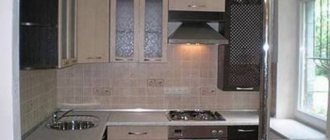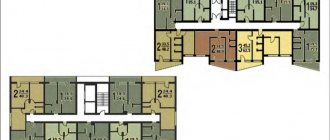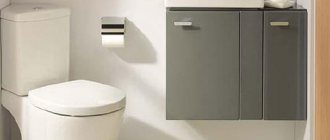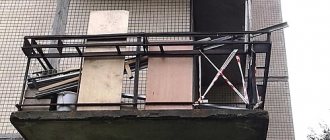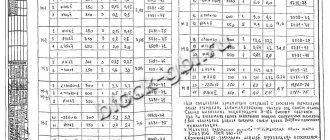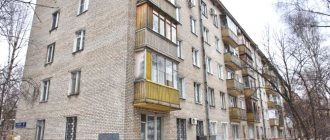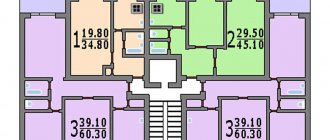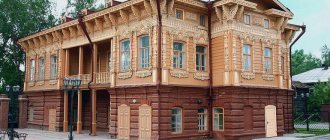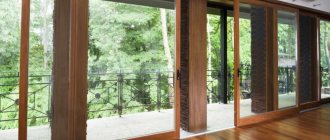Replacement of electrical wiring in a one-room apartment with connection to the electrical panel.
from 25,000 rub.
Order
Replacement of electrical wiring in a two-room apartment with connection to the electrical panel.
from 35,000 rub.
Order
Replacement of electrical wiring in a three-room apartment with connection to the electrical panel.
from 45,000 rub.
Order
Replacement of electrical wiring in the kitchen, hallway, bathroom, toilet with connection to the electrical panel.
from 8,000 rub.
Order
Price list for electrician services in houses of the 1-LG-502 series:
Electrical wiring, replacement of wiring in a one-room apartment - estimate
Example of estimate for 1 sq.m. Total area - 40 sq. m.
Electrical installation work in a one-room apartment (1 square meter)
completed in 1 business day.
| Name of works: | units change | quantity | price | sum |
| Installation of internal sockets with grounding | PC | 10 | 250 | 2500 |
| Installing a TV outlet | PC | 1 | 300 | 300 |
| Installing a telephone/Internet socket | PC | 1 | 300 | 300 |
| Switch installation (one/two sections) | PC | 5 | 250 | 1250 |
| Wall chipping (concrete) | no dust (+250 RUR) | p.m. | 80 | 250 | 20 000 |
| Laying the electrical cable in the groove (NYM 3×1.5 - 3×2.5) | p.m. | 90 | 100 | 9 000 |
| Note: in a new building, it is necessary to drill holes in the wall (socket boxes) to install sockets, and drill holes in the wall for distribution boxes. The cost of work is 200-300 rubles for 1 nest. | ||||
| Total: | 36 350 | |||
| The cost of the material is 10,000 rubles (budget option) | ||||
| Total amount e. work taking into account the material - 46,350 rubles |
Call us: 8 (495) 960-93-41 or Request a call
Installation rules and features
Heating installation is simple. Before it begins, a plan for installing the devices is drawn up, the number of sections on the batteries is determined that provide the necessary heat transfer to heat the room. To determine the thermal power, use data from the corresponding tables and the passport of the installed radiator. Also, to avoid the formation of air jams, when drawing up the wiring diagram, exclude the possibility of a sharp change in height.
Installation of the open horizontal Leningradka is carried out as follows:
- A pipeline is laid around the perimeter of the room, connecting to the boiler. It must have a slope from the accelerating riser to the batteries and back to the boiler. A slope of at least 1 cm per meter is required.
- A vertical pipe for the expansion tank is cut in and the tank is installed at its highest point.
- A heating boiler is installed;
- Batteries are cut into the main pipe according to the selected connection diagram;
- Additional control devices, regulators, taps, and bypasses are installed for the correct and uninterrupted operation of the system.
For a closed heating design, a membrane-type expansion tank is located on the return line, before the location of the fuel unit and electric pump, but after connecting the parallel circuits.
With vertical wiring, the supply and discharge pipes for coolant are located vertically in relation to the radiator. The natural flow of water from top to bottom provides natural partial circulation, which will allow the installation of a lower power electric pump.
Attics and basements are used to place main pipes. When the risers pass through the interfloor ceilings, sleeves are installed. They will prevent direct contact of walls and ceilings with the hot main.
For a forced circulation system, an electric pump is installed. It can be located both on the supply pipe and on the return pipe. Install the pump after the expansion tank and filter with a shut-off valve. In order to be able to clean the filter and remove the pump without draining the water from the system, another tap is installed after the pump.
Diagram of the Leningradka heating system
Open and hidden electrical installation in a house, series 1-LG-502
When considering all the details, the following positive aspects of open installation can be identified:
- replacement can be carried out without subsequent repairs;
- it will take significantly less time than with hidden installation (1-2 days with specialists);
- wiring remains freely accessible
- lower cost of electrical installation in a one-room apartment.
The technique is often used if hidden installation cannot be used due to repairs already made or other circumstances. Despite the fact that the price for installing hidden electrical wiring in a one-room apartment is higher than the previous method, the technology is used much more often due to the following advantages:
- all communications are laid in grooves and sealed, that is, a hidden installation allows you to hide all communications, which has a positive effect on the interior of the room;
- higher tolerances for overload and nominally permissible currents, taking into account the same wiring cross-section, since heat transfer occurs more efficiently;
- installation using this technology is considered more practical and safe, which is especially important if there are children in the family.
- fewer safety requirements according to the PUE - not necessary to apply in all cases
Description
Residential buildings of the 1LG-502 series are more economical than their predecessor series (1-335, 1-507 and OD). This was achieved through an improved system of interpanel seams and joints that eliminated welded joints. The use of panels for two rooms (two steps) further reduced the cost of construction, and at the same time made the appearance attractive. Thanks to the light carpet ceramics on the facades and the contrasting black tiles of the base, the facades of 1LG-502 stood out from the less expressive “Khrushchev” buildings.
Compared to “Khrushchev” apartments, apartments in 1LG-502 are more spacious and equipped with a separate bathroom (albeit compact), and therefore more comfortable. At the same time, it was possible to achieve additional savings - a separate bathroom did not allow reducing the pressure in the pipes, because for the bathroom and toilet there was one drain pipe and one pipe for cold and hot water supply and to reduce the cost of communications, and the increase in area was not achieved, because in the bathroom there was a built-in closet covering the pipes, and in the hallway there was also a built-in closet. Series 1LG-502 has three apartments per floor in sections - 1-2-4 and 2-2-3. Semi-detached sections 3-4 were also built, but due to low demand they were almost never built. The architects included in the project the arrangement of both five-room and six-room apartments for large families. To do this, it was planned to make two-level apartments in one of the row (central) sections, with an internal staircase, and even build a sixth floor above this section. In practice, not a single building of this modification was built.
In recent years, massive overhauls of the facades of some series of houses in St. Petersburg began due to the accident rate and unreliability of carpet tiles, which often collapsed and fell. Plaster is used as a replacement for tiles.
391 buildings were built in St. Petersburg (including one house in Sestroretsk) and one building in Vyborg.
Typical projects
- 1LG-502-6
- 6 entrances, 90 apartments, standard balconies at the end - 1LG-502-7
- 7 entrances, 105 apartments, standard balconies at the end - 1LG-502-9
- 9 entrances, 134 apartments, standard balconies at the end - 1LG-502V-4
- 4 entrances, 60 apartments - 1LG-502V-6
- 6 entrances, 90 apartments, for DSK-1 - 1LG-502V-7
- 7 entrances, 105 apartments of reduced area - 1LG-502V-9
- 9 entrances, 134 apartments. - 1LG-502-6L
- 6 entrances, 70 apartments, loggias, only three- and four-room apartments. - 1LG-502-9L
- 9 entrances, 134 apartments, loggias, only one-, two- and three-room apartments.
Italics indicate projects that were not implemented.
Single-pipe steam and water heating or “Leningradka”
There is only one water supply and return pipe, hence the name - single-pipe. The pipe line leaves the heating boiler and is directed to the heating radiators, passes through them and returns to the boiler.
Passing sequentially through each radiator, the water gives off part of its heat for heating. Thus, it arrives to the very last radiator cooled down.
The temperature difference between the first and last battery can be 10-20 °C.
Pros and cons, can it be used in a multi-storey building?
The advantages of a single-pipe scheme that make it popular:
- Simplicity and affordability - this is the most technologically uncomplicated heating system. To construct it, you will need a minimum number of pipes, which will cost a relatively small amount of money.
- The coolant in the pipes can move by gravity, which is important for autonomous independent heating operation.
The main disadvantage of the system is uneven heating of the rooms. It limits the possibility of using the scheme for multi-story buildings. Accordingly, a single-pipe scheme is not suitable for heating apartments; it is usually used in small houses with an area of up to 100 square meters. m.
Selection of materials and tools
Every job requires a set of materials and tools. And work on installing a heating system is no exception. You will need a tape measure, pliers and a level.
Once the marking is complete, installation will begin. You need tools to connect the components: gas wrenches, adjustable wrenches, wrenches, flat and Phillips screwdrivers, a cutter for polypropylene and metal pipes and a pipe cutter.
When installing heating yourself without proper experience, we recommend using polypropylene pipes. You will need:
- soldering iron (welding machine), which can be bought or rented;
- grinder (115–125 mm);
- drill or hammer drill;
- gas torch for installing copper pipes with fittings.
Welding machine for polypropylene pipes
This is a list of the main tools, and if something is missing, you will understand during the work and buy more.
In addition to the tools, you will need a boiler, batteries (1 section per 3 m2), a metal-plastic or propylene pipe, taps and valves.
Check the readiness of materials and tools and proceed with installation.
Suitable radiators
The choice of radiators is made by the owner of the house or the builders performing the work. In resolving the issue, you should rely on personal experience and financial capabilities. To make the right choice, you need to clearly understand the end result. It is useful to study the demand and prices of a given product. A careful approach will simplify the choice. It is necessary to take into account the types of radiators, of which there are 4 types:
- Aluminum
- Bimetallic
- Cast iron
- Steel
It is necessary to calculate the heat consumed in the rooms. This is necessary to determine the power of the selected radiator.
Tips for choosing a radiator:
- Select an average price product
- Take into account external data, combination with the interior
- Take into account the floor of the system placement
- In a private house, you need to take into account the maximum heating temperature of the coolant
- Find out the conditions for connecting the system
- Inquire about the weight of the product, mounting methods
- Make a power calculation
If the choice in Leningrad is made in favor of aluminum radiators, you need to study their capabilities. The product is made by casting. Represents a single non-demountable section. Assembly is carried out from the required number of sections.
Advantages of aluminum batteries:
- Light weight
- High heat dissipation
- Small coolant volume
- Modern design
- Affordable price
Flaws:
- Aluminum is susceptible to corrosion
- Sensitivity to coolant composition
A possible option is bimetal radiators. Radiators made of two metals. The most common duets are aluminum-copper and aluminum-steel. In both cases they complement each other perfectly. The pipes located inside the housing serve to:
- Prevent the penetration of harmful substances into the battery case
- Increase system reliability
- These properties are among the advantages of choice. The negative sides are:
- High price
- The pipe may burst under the influence of temperature changes
